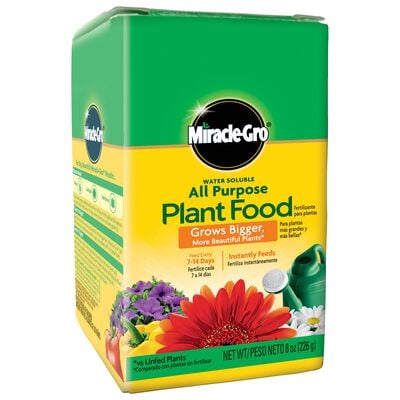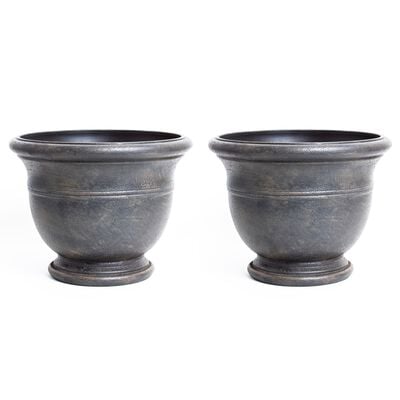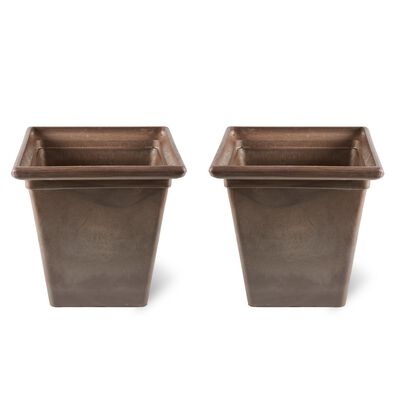
Tips for Watering Potted Plants
Container plants depend on you—keep them happy by becoming a water whisperer.
Have you ever watered your outdoor potted plants on a hot summer morning, left for the day, and returned to find them barely clinging to life? Don't worry—it wasn't your fault. Potted plants dry out much more quickly than their in-the-ground counterparts, so they're more vulnerable to the scorching summer sun.
See, plants growing in garden beds and borders have plenty of space for their roots to spread out and find the water they need in the soil. But potted plants have to rely on the limited moisture that's within their containers, making them dependent on you. That's why it's really important to know the best way to water your plants. So, let's dig in!
Start Smart
Make sure you're giving your plants the best chance at a bright future by starting this garden party right.
Consider the Container
Believe it or not, the road to keeping your plants happy and hydrated starts when you choose the containers they’re going to live in. Clay and terracotta pots are porous, so they absorb—and lose—moisture faster than pots made from other materials. Unless you’re a diligent waterer, that can result in chronically thirsty plants. Containers made of glazed ceramic, concrete, metal, wood, fiberglass, resin, or plastic, on the other hand, are a little more forgiving. As for those cute coconut-fiber-lined wire baskets, they’re a fine choice, but add a plastic sheet liner to slow moisture loss.
Let It Drain
Whichever material you choose, make sure the pot has drainage holes so extra water will flow out, not stick around and give your plants wet feet. If you use a saucer underneath the pot, make a point to dump any water that collects in it.
Make It Comfy
It also helps to fill containers with a premium, lightweight potting mix. This makes it easy for moisture to move through the soil and reach thirsty plant roots. It’s also a good idea to add a layer of mulch over the soil surface to help keep the soil moist and weeds to a minimum, plus give your plantings a more polished look.

Water Wisely
So, how often should you water? There's no one hard-and-fast answer to that question, since there are so many variables—think rain, sun, heat, humidity, etc. Plant type matters, too: Succulents, cactuses, and some herbs need less water than most flowering plants and vegetables.
Check Them Daily
So here's what to do: Check potted plants daily by plunging your finger knuckle-deep into containers and feeling around—after all, what matters most is the moisture level at root-depth. If it's dry down there, it's time to give plants a thorough watering.
Some plants will get all dramatic by making a show of droopy leaves, limp stems, and wilted flowers when they're thirsty. But fear not: Once those divas get a drink, they usually bounce back within an hour—as long as you didn't ignore their cries for too long.
Time It Right
Timing-wise, it's always best to water in the morning so plants and soil don't remain damp overnight, but know that during hot, dry spells, you might need to water again later in the day. If possible, use a watering can or hand-held hose and apply water slowly and directly to the soil at the base of the plant, where it's needed. Too much water too fast will pass through dry soil and run right out the drainage holes—not particularly helpful.
Go Automatic
If you have a lot of plants or are too busy to give each plant this level of personal attention (and let's face it, many of us are), you can simplify the process with a drip-irrigation kit. Made of quarter-inch micro-tubing that coils over the soil surface and attaches to a spigot, it can water multiple pots at once with a turn of the faucet. After setting it up, run the water for 5 minutes, then check the soil. If it's too dry, experiment by adding one minute at a time until you achieve evenly moist (but not soggy) soil. Manually turn on the faucet whenever you need to water plants, or set the system on a timer. A one-size-fits-all schedule isn't ideal, but it's better than nothing—and usually good enough—if you're short on time or planning to be away on vacation.
A self-watering container can also save you some time. An inner compartment holds the plant while the outer one serves as a water reservoir, and a cotton wick connects the two. Whenever the soil starts to dry out, the wick moves water from the reservoir to the soil. Fill the reservoir the first time and check it daily, so you'll have an idea of how quickly it empties out. Then, refill it based on what you discover.
You can even make your own self-watering system by drilling or cutting holes around the top of a plastic soda bottle, filling it with water, and screwing on the cap. Water your plant thoroughly (this is important!), then quickly turn the bottle upside down, pushing its top portion into the soil until the holes are buried. Water will slowly leach out and keep the soil moist—just be sure to check often to see if it needs to be refilled, especially if it's hot and dry outside.
A word of caution: Don’t succumb to the temptation to use an overhead sprinkler. Wet foliage is an open invitation for mold, mildew, and fungal diseases to take hold.
Don't Forget to Feed
Remember when we said your potted plants were dependent on you? That goes for nutrients as well as water. But fertilizing doesn't have to be a hassle—in fact, you can feed plants while you water. Adding a packet of plant food into your watering can every week or two will provide flowers, fruits, and vegetables with all the nutrition they need without adding more work for you.
It's true, figuring out the best routine to keep plants hydrated and happy requires a bit of attention. But considering the beauty they add to our patios, gardens, and lives, it's a small price to pay!


